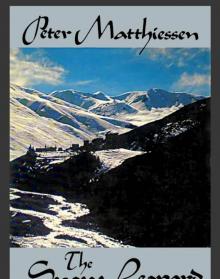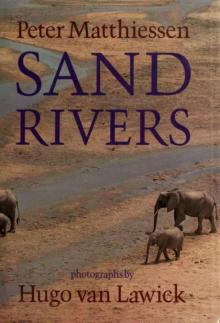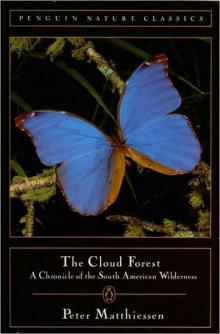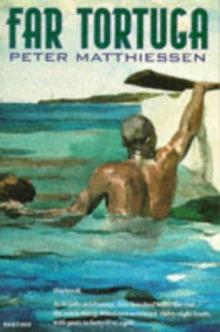- Home
- Peter Matthiessen
The Snow leopard
The Snow leopard Read online
CONTENTS
Prologue
I WESTWARD
II NORTHWARD
III AT CRYSTAL MOUNTAIN
IV THE WAY HOME
Acknowledgments
Notes
Index
That is at bottom the only courage that is demanded of us: to have courage for the most strange, the most singular and the most inexplicable that we may encounter. That mankind has in this sense been cowardly has done life endless harm; the experiences that are called "visions," the whole so-called "spirit-world" death, all those things that are so closely akin to us, have by daily parrying been so crowded out of life that the senses with which we could have grasped them are atrophied. To say nothing of God.
RAINER MARIA RILKE
PROLOGUE
In late SEPTEMBER of 1973, I set out with GS on a journey to the Crystal Mountain, walking west under Annapurna and north along the KaH Gandaki River, then west and north again, around the Dhaulagiri peaks and across the Kanjiroba, two hundred and fifty miles or more to the Land of Dolpo, on the Tibetan Plateau.
GS is the zoologist George Schaller. I knew him first in 1969, in the Serengeti Plain of East Africa, where he was working on his celebrated study of the lion.1 When I saw him next, in New York City in the spring of 1972, he had started a survey of wild sheep and goats and their near relatives the goat-antelopes. He wondered if I might like to join him the following year on an expedition to northwest Nepal, near the frontier of Tibet, to study the bharal, or Himalayan blue sheep; it was his feeling, which he meant to confirm, that this strange "sheep" of remote ranges was actually less sheep than goat, and perhaps quite close to the archetypal ancestor of both. We would go in the autumn to observe the animals in rut, since the eating and sleeping that occupied them throughout the remainder of the year gave almost no clue to evolution and comparative behavior. Near Shey Gompa, "Crystal Monastery," where the Buddhist lama had forbidden people to molest them, the bharal were said to be numerous and easily observed. And where bharal were numerous, there was bound to appear that rarest and most beautiful of the great cats, the snow leopard. GS knew of only two Westerners—he was one—who had laid eyes on the Himalayan snow leopard in the past twenty-five years; the hope of glimpsing this near-mythic beast in the snow mountains was reason enough for the entire journey.
Twelve years before, on a visit to Nepal, I had seen those astonishing snow peaks to the north; to close that distance, to go step by step across the greatest range on earth to somewhere called the Crystal Mountain, was a true pilgrimage, a journey of the heart. Since the usurpation of Tibet by the Chinese, the Land of Dolpo, all but unknown to Westerners even today, was said to be the last enclave of pure Tibetan culture left on earth, and Tibetan culture was the last citadel of "all that present-day humanity is longing for, either because it has been lost or not yet been realized or because it is in danger of disappearing from human sight: the stability of a tradition, which has its roots not only in a historical or cultural past, but within the innermost being of man. . . ."2 The Lama of Shey, the most revered of all the rinpoches, the "precious ones," in Dolpo, had remained in seclusion when a scholar of Tibetan religions3 reached the Crystal Monastery seventeen years ago, but surely our own luck would be better.
On the way to Nepal, I stopped at Varanasi, the holy city on the Ganges, and visited the Buddhist shrines at Bodh Gaya and Samath. In those monsoon days of mid-September, the brown heat of India was awesome, and after a few days on the Ganges Plain, I was glad to fly north to Kathmandu, in the green foothills of the Himalayan wall. That day was clear, and among the temple spires and tiered pagodas, black kites and red veered on the wind. The dry air at 4000 feet was a great relief from the humidity of India, but in the north the peaks were hidden by thick clouds of the monsoon, and by evening it was raining.
I found GS at the hotel. We had not met in a year or more, our last correspondence had been in midsummer, and he was relieved that I had turned up without mishap. For the next two hours we talked so intensely that I wondered later if there was anything left to speak about in the months ahead; we shall have no company but each other, and we do not know each other very well. (Of GS, I had written earlier that 'Tie is single-minded, not easy to know," and "a stern pragmatist, unable to muster up much grace in the face of unscientific attitudes; he takes a hard-eyed look at almost everything." He was also described as a "lean. intent young man,"4 and I find Him as lean and as intent as ever.)
The rains prevailed throughout the last three days in Kathmandu. GS was desperate to get under way, not only because he loathes all cities but because winter comes early to the Himalaya, and these rains of the monsoon would bring heavy snow to the high passes between this place and our destination. (We later learned that the October rains set an all-time record.) Months before, he had applied for permission to enter Dolpo, but only now, on the final day, were permits granted. Last letters were written and sent off; there would be no mail where we were going. All excess gear and clothing were discarded, and traveler s checks exchanged for small rupee notes by the dirty packet, since large bills have no currency among the hill peoples. With our Sherpa camp assistants, we packed tents and pots, and bargained for last-minute supplies in the Oriental rumpus of the Asan Bazaar, where in 19611 had bought a small bronze Buddha, green with age. My wife and I were to become students of Zen Buddhism, and the green bronze Buddha from Kathmandu was the one I chose for a small altar in Deborah's room in the New York hospital where she died last year of cancer, in the winter.
In the early morning of September 26, in a hard rain, with a driver, two Sherpas, and all expedition gear, we packed ourselves into the Land Rover that would carry us as far as Pokhara; two more Sherpas and five Tamang porters were to come next day by bus, in time for departure from Pokhara on the twenty-eighth. But all arrivals and departures were in doubt; it had rained without relent for thirty hours. In the calamitous weather, the journey was losing all reality, and the warm smile of a pretty tourist at the hotel desk unsettled me; where did I imagine I was going, where and why?
From Kathmandu there is a road through Gorkha
Country to Pokhara, in the central foothills; farther west, no roads exist at all. The road winds through steep gorges of the Trisuli River, now in torrent; dirty whitecaps filled the rapids, and the brown flood was thickened every little while by thunderous rockslides down the walls of the ravine. Repeatedly the rocks fell on the road: the driver would wait for the slide to ease, then snake his way through the debris, while all heads peered at the boulders poised overhead. In raining mountains, a group of shrouded figures passed, bearing a corpse, and the sight aroused a dim, restless foreboding.
After midday, the rain eased, and the Land Rover rode into Pokhara on a shaft of storm light. Next day there was humid sun and shifting southern skies, but to the north a deep tumult of swirling grays was all that could be seen of the Himalaya. At dusk, white egrets flapped across the sunken clouds, now black with rain; on earth, the dark had come. Then, four miles above these mud streets of the lowlands, at a point so high as to seem overhead, a luminous whiteness shone—the light of snows. Glaciers loomed and vanished in the grays, and the sky parted, and the snow cone of Machhapuchare glistened like a spire of a higher kingdom.
In the night, the stars convened, and the vast ghost of Machhapuchare radiated light, although there was no moon. In the shed where we lay down, behind a sort of inn, there were mosquitoes. My friend, dreaming, cried out in his sleep. Restless, I went out at daybreak and saw three peaks of Annapurna, soaring clear of low, soft clouds. This day we would depart for the northwest.
WESTWARD
Just as a white summer cloud, in harmony with heaven and earth freely floats in the blue sky from hori
zon to horizon following the breath of the atmosphere — in the same way the pilgrim abandons himself to the breath of the greater life that . . . leads him beyond the farthest horizons to an aim which is already present within him, though yet hidden from his sight.
LAMA GOVINDA
The Way of the White Clouds
All other creatures look down toward the earth, hut man was given a face so that he might turn his eyes toward the stars and his gaze upon the sky.
OVID
Metamorphoses
SEPTEMBER 28
At sunrise the small expedition meets beneath a giant fig beyond Pokhara—two white sahibs, four sherpas, fourteen porters. The sherpas are of the famous mountain tribe of northeast Nepal, near Namche Bazaar, whose men accompany the ascents of the great peaks; they are Buddhist herders who have come down in recent centuries out of eastern Tibet— sherpa is a Tibetan word for "easterner"—and their language, culture, and appearance all reflect Tibetan origin. One of the porters is also a Sherpa, and two are refugee Tibetans; the rest are of mixed Aryan and Mongol stock. Mostly barefoot, in ragged shorts or the big-seated, jodhpur-legged pants of India, wearing all manner of old vests and shawls and headgear, the porters pick over the taU wicker baskets. In addition to their own food and blankets, they must carry a load of up to eighty pounds that is braced on their bent backs by a tump line around the forehead, and there is much hefting and denunciation of the loads, together with shrill bargaining, before any journey in these mountains can begin. Porters are mostly local men of uncertain occupation and unsteadfast habit, notorious for giving trouble. But it is also true that their toil is hard and wretchedly rewarded—about one dollar a day. As a rule, they accompany an expedition for no more than a week away from home, after which they are replaced by others, and the hefting and denunciation start anew. Today nearly two hours pass, and clouds have gathered, before all fourteen are mollified, and the tattered line sets off toward the west.
We are glad to go. These edges of Pokhara might be tropical outskirts anywhere—vacant children, listless adults, bent dogs and thin chickens in a Utter of sagging shacks and rubble, mud, weeds, stagnant ditches, bad sweet smells, vivid bright broken plastic bits, and dirty fruit peelings awaiting the carrion pig; for want of better fare, both pigs and dogs consume the human excrement that lies everywhere along the paths. In fair weather, all this flux is tolerable, but now at the dreg end of the rainy season, the mire of life seems leached into the sallow skins of these thin beings, who squat and soap themselves and wring their clothes each morning in the rain puddles.
Brown eyes observe us as we pass. Confronted with the pain of Asia, one cannot look and cannot turn away. In India, human misery seems so pervasive that one takes in only stray details; a warped leg or a dead eye, a sick pariah dog eating withered grass, an ancient woman lifting her sari to move her shrunken bowels by the road. Yet in Varanasi there is hope of life that has been abandoned in such cities as Calcutta, which seems resigned to the dead and dying in its gutters. Shiva dances in the spicy foods, in the exhilarated bells of the swarming bicycles, the angry bus horns, the chatter of the temple monkeys, the vermilion tikka dot on the women's foreheads, even in the scent of charred human flesh that pervades the ghats. The people smile —that is the greatest miracle of all. In die heat and stench and shriek of Varanasi, where in fiery sunrise swallows fly like departing spirits over the vast silent river, one delights in the smile of a blind girl being led, of a Hindu gentleman in white turban gazing benignly at the bus driver who reviles him, of a flute-playing beggar boy, of a slow old woman pouring holy water from Ganga, the River, onto a stone elephant daubed red.
Near the burning ghats, and the industry of death, a river palace has been painted with huge candy-striped tigers.
No doubt Varanasi is the destination of this ancient Hindu at the outskirts of Pokhara, propped up on a basket borne on poles across the shoulders of four servants—off, it appears, on his last pilgrimage to the Mother Ganges, to the dark temples that surround the ghats, to those hostels where the pilgrim waits his turn to join the company of white-shrouded cadavers by the river edge, waits again to be laid upon the stack of fired wood: the attendants will push this yellow foot, that shriveled elbow, back into the fire, and rake his remains off the burning platform into the swift river. And still enough scraps will remain to sustain life in the long-headed cadaverous dogs that haunt the ashes, while sacred kine—huge white silent things—devour the straw thongs that had bound this worn-out body to its stretcher.
The old man has been ravened from within. That blind and greedy stare of his, that caved-in look, and the mouth working, reveal who now inhabits him, who now stares out.
I nod to Death in passing, aware of the sound of my own feet upon my path. The ancient is lost in a shadow world, and gives no sign.
Gray river road, gray sky. From rock to torrent rock flits a pied wagtail.
Wayfarers: a delicate woman bears a hamper of small silver fishes, and another bends low beneath a basket of rocks that puts my own light pack to shame; her rocks will be hammered to gravel by other women of Pokhara, in the labor of the myriad brown hands that will surface a new road south to India.
Through a shaft of sun moves a band of Magar women, scarlet-shawled; they wear heavy brass ornaments in the left nostril. In the new sun, a red-combed rooster clambers quickly to the roof matting of a roadside hut, and fitfully a little girl starts singing. The light irradiates white peaks of Annapurna marching down the sky, in the great rampart that spreads east and west for eighteen hundred miles, the Himalaya— the alaya (abode, or home) of hima (snow).
Hibiscus, frangipani, bougainvillea: seen under snow peaks, these tropical blossoms become the flowers of heroic landscapes. Macaques scramper in green meadow, and a turquoise roller spins in a golden light. Drongos, rollers, barbets, and the white Egyptian vulture are the common birds, and all have close relatives in East Africa, where GS and I first met; he wonders how this vulture would react if confronted with the egg of an ostrich, which was also a common Asian bird during the Pleistocene. In Africa, the Egyptian vulture is recognized as a tool-using species, due to its knack of cracking the huge ostrich eggs by slinging rocks at them with its beak.
Until quite recently, these Nepal lowlands were broadleaf evergreen sal forest (Shorea rohusta), the haunt of elephant and tiger and the great Indian rhinoceros. Forest-cutting and poaching cleared them out; except in last retreats such as the Rapti Valley, to the southeast, the saintly tread of elephants is gone. The last wild Indian cheetah was sifted in central India in 1952, the Asian lion is reduced to a single small population in the Gir Forest, northwest of Bombay, and the tiger becomes legendary almost everywhere. Especially in India and Pakistan, the hoofed animals are rapidly disappearing, due to destruction of habitat by subsistence agriculture, over-cutting of the forests, overgrazing by the scraggy hordes of domestic animals, erosion, flood—the whole dismal cycle of events that accompanies overcrowding by human beings. In Asia more than all places on earth, it is crucial to establish wildlife sanctuaries at once, before the last animals are overwhelmed. As GS has written, "Man is modifying the world so fast and so drastically that most animals cannot adapt to the new conditions. In the Himalaya as elsewhere there is a great dying, one infinitely sadder than the Pleistocene extinctions, for man now has the knowledge and the need to save these remnants of his past."1
The track along the Yamdi River is a main trading route, passing through rice paddies and villages on its way west to the Kali Gandaki River, where it turns north to Mustang and Tibet. Green village compounds, set about with giant banyans and old stone pools and walls, are cropped to lawn by water buffalo and cattle; the fresh water and soft shade give them the harmony of parks. These village folk own even less than those of Pokhara, yet they are spared by their old economies from modern poverty: one understands why "village life" has been celebrated as the natural, happy domain of man by many thinkers, from Lao-tzu to Gandhi. In a warm sun children p
lay, and women roll clothes on rocks at the village fountain and pound grain in stone mortars, and from all sides come reassuring dung smells and chicken clatter and wafts of fire smoke from the low hearths. In tidy yards, behind strong stiles and walls, the clay huts are of warm earthen red, with thatched roofs, hand-carved sills and shutters, and yellow-flowered pumpkin vines. Maize is stacked in narrow cribs, and rice is spread to dry on broad straw mats, and between the banana and papaya trees big calm spiders hang against the sky.
A canal bridged here and there by ten-foot granite slabs runs through a hamlet, pouring slowly over shining pebbles. It is midday, the sun melts the air, and we sit on a stone wall in the cool shade. By the canal is the village tea house, a simple open-fronted hut with makeshift benches and a clay oven in the form of a rounded mound on the clay floor. The mound has a side opening for inserting twigs and two holes on the top for boiling water, which is poured through a strainer of cheap tea dust into a glass containing coarse sugar and buffalo milk. With this chiya we take plain bread and a fresh cucumber, while children playing on the shining stones pretend to splash us, and a collared dove sways on a tall stalk of bamboo.
One by one the porters come, turning around to lower their loads onto the wall. A porter of shy face and childlike smile, who looks too slight for his load, is playing comb music on a fig leaf. "Too many hot," says another, smiling. This is the Sherpa porter, Tukten, a wiry small man with Mongol eyes and out-sized ears and a disconcerting smile—I wonder why this Tukten is a porter.
I set off ahead, walking alone in the cool breeze of the valley. In the bright September light and mountain shadow—steep foothills are closing in as the valley narrows, and the snow peaks to the north are no longer seen—the path follows a dike between the reedy canal and the green terraces of rice that descend in steps to the margins of the river. Across the canal, more terraces ascend to the crests of the high hills, and a blue sky.

 Lost Man's River: Shadow Country Trilogy
Lost Man's River: Shadow Country Trilogy The Tree Where Man Was Born
The Tree Where Man Was Born The Snow leopard
The Snow leopard Sand Rivers
Sand Rivers The Cloud Forest
The Cloud Forest Sal Si Puedes (Escape if You Can)
Sal Si Puedes (Escape if You Can) Far Tortuga
Far Tortuga Men's Lives
Men's Lives On the River Styx: And Other Stories
On the River Styx: And Other Stories Shadow Country
Shadow Country At Play in the Fields of the Lord
At Play in the Fields of the Lord Lost Man's River
Lost Man's River Killing Mister Watson
Killing Mister Watson On the River Styx
On the River Styx